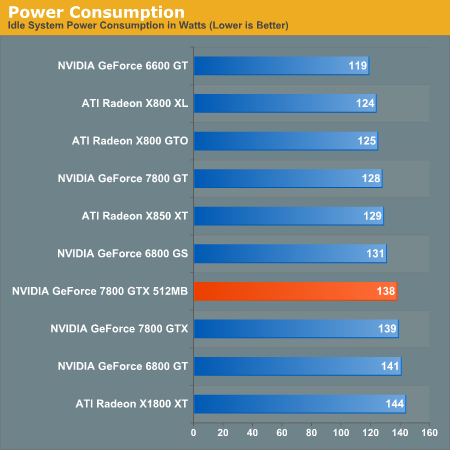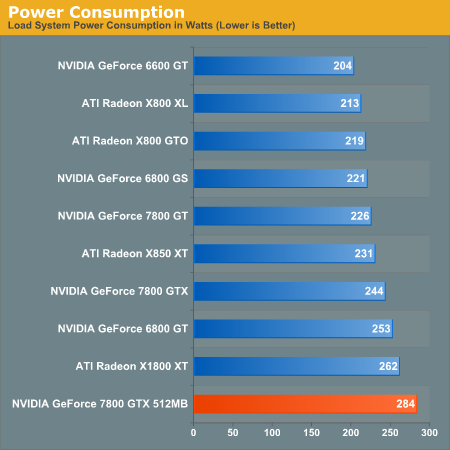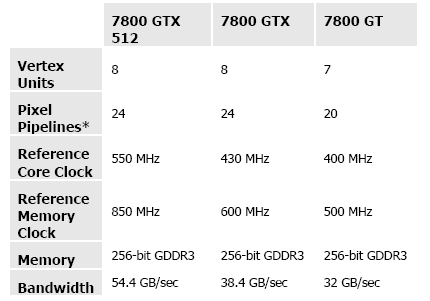NVIDIA GeForce 7800 GTX 512: More Than Just More Memory
by Derek Wilson on November 14, 2005 9:00 AM EST- Posted in
- GPUs
The Card, The Test, and Power
There are a few key changes from the original 7800 GTX silicon that allow the 7800 GTX 512 to perform so highly. The 7800 GTX 512 still uses a 110nm process like the original 7800 GTX, but NVIDIA has tuned their fab process to speed up key data paths in the chip. These enhancements, while not altering the feature set in anyway, allow the chip to reach clock speeds of 550MHz (which is 120MHz faster than the original 7800 GTX). On top of changes in the silicon, the 7800 GTX 512 has gotten a PCB revision. And just in case anyone is wondering, the huge HSF solution is actually very quiet. NVIDIA is using a fan with larger blades that move a good volume of air without needing to run at super high RPMs. While it may look like an industrial sized leaf blower, it bark is certainly nothing compared to the bite this thing takes out of our performance tests.
Current 7800 GTX cards feature 8Mx32 GDDR3 with four chips on each side of the PCB. Most cards have a heat spreader on the back of the board, while some vendors have attached heatsinks. NVIDIA needed a better way to cool their RAM in order to hit the memory clock speeds they wanted. To this end the 7800 GTX 512 sees all of its RAM on the front of the PCB cooled by the very large heatsink previously employed on the Quadro FX 4500. Moving all the RAM to one side of the PCB may also have improved the routing to certain memory modules, which would also help increase attainable stable memory clock speeds. There are still only 8 modules total, as NVIDIA has also moved to higher density 16Mx32 GDDR3. The RAM used is also rated at 900MHz (1800MHz data rate), giving the stock memory clock speed of 1700MHz a little head room for vendors who like to overclock the cards they sell.
Here is a quick comparison of NVIDIA's 7800 series line up with the new GTX 512:
Slower architectures have the advantage of being less effected by latency as a long clock cycle time allows data to move further per cycle. At the same time, to compete with high frequency processing, much more work has to get done per clock cycle than a faster chip. Graphics tend to lend themselves to this type of architecture, which is partly why we haven't seen multiple-GHz graphics chips.
In any case, increasing core and memory clocks, framebuffer size, and adding a gigantic HSF will certainly require a little more power than the standard 7800 GTX. NVIDIA currently still recommends the same types of power supplies for the 7800 GTX 512 as it does for the 7800 GTX, but, as we can see from our tests, the 7800 GTX 512 does result in a much higher power draw from the wall. In fact, the outlets in our lab had some trouble getting consistent power to our PSU during SLI testing. Most people won't run into a problem like this unless they run quite a few PCs off the same circuit breaker at home. We actually had to solve our problem by running one of the 7800 GTX 512 cards off of a second power supply plugged into an extension cord running off of a different circuit. If nothing else, this setup could help people test for wiring problems in their homes.
These power numbers are measured at the wall before the PSU.


Certainly the 7800 GTX 512 is a power hog to say the least. Unfortunately, we didn't have a reliable way to test power draw for the 7800 GTX 512 SLI setup, but if we ever get around to rewiring the lab ...
Let's take a look at the hardware we will use.
Test Hardware
This is definitely a powerful system we will be examining today. For our benchmarks, we test with sound disabled. Most of these tests are timedemos played back using ingame functionality, but the Black & White 2 benchmark is a FRAPS test using an ingame cut scene. We will provide bar graphs for the very popular 1600x1200 resolution while reporting data from 1280x960 to 2048x1536 in resolution scaling graphs.
There are a few key changes from the original 7800 GTX silicon that allow the 7800 GTX 512 to perform so highly. The 7800 GTX 512 still uses a 110nm process like the original 7800 GTX, but NVIDIA has tuned their fab process to speed up key data paths in the chip. These enhancements, while not altering the feature set in anyway, allow the chip to reach clock speeds of 550MHz (which is 120MHz faster than the original 7800 GTX). On top of changes in the silicon, the 7800 GTX 512 has gotten a PCB revision. And just in case anyone is wondering, the huge HSF solution is actually very quiet. NVIDIA is using a fan with larger blades that move a good volume of air without needing to run at super high RPMs. While it may look like an industrial sized leaf blower, it bark is certainly nothing compared to the bite this thing takes out of our performance tests.
Current 7800 GTX cards feature 8Mx32 GDDR3 with four chips on each side of the PCB. Most cards have a heat spreader on the back of the board, while some vendors have attached heatsinks. NVIDIA needed a better way to cool their RAM in order to hit the memory clock speeds they wanted. To this end the 7800 GTX 512 sees all of its RAM on the front of the PCB cooled by the very large heatsink previously employed on the Quadro FX 4500. Moving all the RAM to one side of the PCB may also have improved the routing to certain memory modules, which would also help increase attainable stable memory clock speeds. There are still only 8 modules total, as NVIDIA has also moved to higher density 16Mx32 GDDR3. The RAM used is also rated at 900MHz (1800MHz data rate), giving the stock memory clock speed of 1700MHz a little head room for vendors who like to overclock the cards they sell.
Here is a quick comparison of NVIDIA's 7800 series line up with the new GTX 512:

Slower architectures have the advantage of being less effected by latency as a long clock cycle time allows data to move further per cycle. At the same time, to compete with high frequency processing, much more work has to get done per clock cycle than a faster chip. Graphics tend to lend themselves to this type of architecture, which is partly why we haven't seen multiple-GHz graphics chips.
In any case, increasing core and memory clocks, framebuffer size, and adding a gigantic HSF will certainly require a little more power than the standard 7800 GTX. NVIDIA currently still recommends the same types of power supplies for the 7800 GTX 512 as it does for the 7800 GTX, but, as we can see from our tests, the 7800 GTX 512 does result in a much higher power draw from the wall. In fact, the outlets in our lab had some trouble getting consistent power to our PSU during SLI testing. Most people won't run into a problem like this unless they run quite a few PCs off the same circuit breaker at home. We actually had to solve our problem by running one of the 7800 GTX 512 cards off of a second power supply plugged into an extension cord running off of a different circuit. If nothing else, this setup could help people test for wiring problems in their homes.
These power numbers are measured at the wall before the PSU.


Certainly the 7800 GTX 512 is a power hog to say the least. Unfortunately, we didn't have a reliable way to test power draw for the 7800 GTX 512 SLI setup, but if we ever get around to rewiring the lab ...
Let's take a look at the hardware we will use.
Test Hardware
| CPU: | AMD Athlon 64 FX-57 (2.8GHz) |
| Motherboard: | ASUS A8N32-SLI Deluxe |
| Chipset: | NVIDIA nForce4 SLI X16 |
| Chipset Drivers: | nForce4 6.82 |
| Memory: | OCZ PC3500 DDR 2-2-2-7 |
| Video Card: | ATI Radeon X800 XL ATI Radeon X1800 XT ATI Radeon X850 XT NVIDIA GeForce 6800 GS NVIDIA GeForce 7800 GT NVIDIA GeForce 7800 GTX NVIDIA GeForce 7800 GTX 512 |
| Video Drivers: | ATI Catalyst 5.11 (WHQL) NVIDIA ForceWare 81.89 (Beta) |
| Desktop Resolution: | 1280x960 - 32-bit @ 60Hz |
| OS: | Windows XP Professional SP2 |
| Power Supply: | OCZ PowerStream 600W PSU |
This is definitely a powerful system we will be examining today. For our benchmarks, we test with sound disabled. Most of these tests are timedemos played back using ingame functionality, but the Black & White 2 benchmark is a FRAPS test using an ingame cut scene. We will provide bar graphs for the very popular 1600x1200 resolution while reporting data from 1280x960 to 2048x1536 in resolution scaling graphs.










97 Comments
View All Comments
Gogar - Saturday, November 19, 2005 - link
The only thing i'm still wondering about is what the performance difference between the 1800XT and the 7800GTX 512 would be if a dual core processor was used.Since Nvidia makes use of dual core with their drivers, the gap might be even wider.. but who knows?
Regs - Friday, November 18, 2005 - link
I doubt Nvidia cared about it's price/performance one bit. This card is just a spin-off to show what 512 MB's can do....(nothing). You give a GTX a 120 MHz core speed bump with a 200 MHz RAM bump and of course it's going to perform better than the GTX 256. Pure marketing. 700 dollars? What target market is this? And even better that they decided to keep the name to make it more confusing. Let's see how much money we can squeeze out of you by putting in more RAM which Vendors all ready have ordered in Bulk 8 months ago.Regs - Friday, November 18, 2005 - link
In other words you are paying 300 dollars more for a GTX with a better HSF unit.cryptonomicon - Tuesday, November 15, 2005 - link
awesome card, i'm a bit confused though as to what nvidia was trying to release it as though.the boosted clock speeds are typical of the mid-quarter 'refresher' products (same core, with boosted stats) but it also is posing as the same product but in a 512mb variation.
i think it should have a new model name (*agree* with derek!)
MadAd - Tuesday, November 15, 2005 - link
LOL! Thats what I thought, I wonder if he read the same review as we did? 2x GTs SLId are either within a couple of fps, or between 10-20 fps higher. Considering the GT is just over 200 here, I can get 2 and add an extra 50 for an sli board (over a non sli) and still save 50 notes.As for soundcards, well its not a soundcard review so I dont want sound complicating anything. If I was really perdantic i'd say ATs review of the motherboard showed the a8n32 to be several FPS above all the rest of the mobos currently and would skew the data higher than normal boards, but thats not the point, the point is about comparability on the same platform.
Finally, another thanks goes to Derek for the higher resolution coverage - although some here are mystified why resolutions above 1600x1200 are mentioned, well some of us have TFTs with native resolutions of 1920x1200 and anything lower has to be either stretched or windowed- thats not what I paid all that money to do, I want fullscreen lovelyness at full res and right now, thanks to Dereks patience, I can see that the minimum setup to enjoy all current games with FSAA at 1920x1200 is 2xGTs. Even the GTX512 isnt quite man enough.
MadAd - Tuesday, November 15, 2005 - link
OOps, that was in reply to:RE: Newegg has it!!!! by viciousvee on: Nov 14, 2005 10:53 PM
Might want to read the Review again (just a thought) but the GT SLI pretty much beats the GTX 512mb ("NON SLI") by a few FPS... So I stand by what I said, Get "TWO" GT's (7800) and Call it a day....
Eidolon - Monday, November 14, 2005 - link
I am guessing you cannot SLI this card with an existing 7800 GTX 256MB. Is this correct?Fluppeteer - Tuesday, November 15, 2005 - link
ISTR Tom's tried it, and no, you can't. (Presumably the core is tweakedjust enough that it doesn't work.)
Maybe nVidia will fix that in a new driver?
jeffrey - Monday, November 14, 2005 - link
Derek,I have been an open critic of some of your recent work, but this review was fairly solid. Don't sweat someone saying a sentence was a run-on. The review read as an unbiased work and was inquisitive where it needed to be.
Thanks for including the disclaimer for multiple-clocks on lowering the core clock. The addition of the 256mb vs. 512mb benchmarks was a welcome addition.
That's all,
Jeffrey
ElJefe - Monday, November 14, 2005 - link
Eh. I dont see the point of playing at 1600 yet, so I wouldnt be TOO concerned with needing to upgrade. Obviously, this is an amazing card though, so that cant be said enough.anything over 300 dollars for a non all-in-wonder vid card is a ripoff though. x800XL is still more than adequate. Dont listen to the hype.